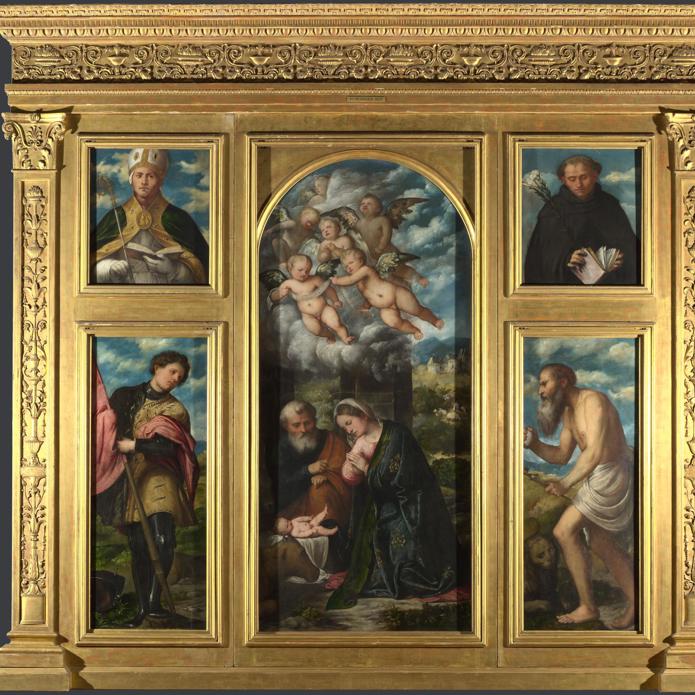Girolamo Romanino, 'Saint Jerome', about 1524
About the work
Overview
This painting is part of Romanino’s high altarpiece for S. Alessandro in Brescia. It is situated to the right of the main panel of the Nativity and shows the theologian, priest and historian, Saint Jerome (347–420), who lived in Constantinople and Rome.
Saint Jerome holds a crucifix and beats his chest with a stone as penance for his sinful thoughts. The Cross is formed from rough sticks, but the body of Christ is flesh coloured and spots of blood can be seen on the hands, hair, feet and side. The lion at Jerome’s feet is one of his attributes and refers to the legend that he befriended a lion while living in the desert.
There is no reason obvious to us today for why Saint Jerome was chosen for this altarpiece. The other three saints represented all had specific connections to the church, so Saint Jerome must have had some special significance of which we are now unaware.
Key facts
Details
- Full title
- Saint Jerome
- Artist
- Girolamo Romanino
- Artist dates
- about 1484 - about 1560
- Part of the group
- High Altarpiece, S. Alessandro, Brescia
- Date made
- about 1524
- Medium and support
- oil on wood
- Dimensions
- 159.1 × 64.8 cm
- Acquisition credit
- Bought, 1857
- Inventory number
- NG297.3
- Location
- Not on display
- Collection
- Main Collection
- Frame
- 19th-century Italian Frame
Provenance
Additional information
Text extracted from the ‘Provenance’ section of the catalogue entry in Nicholas Penny, ‘National Gallery Catalogues: The Sixteenth Century Italian Paintings’, vol. 1, ‘Paintings from Bergamo, Brescia and Cremona’, London 2004; for further information, see the full catalogue entry.
Bibliography
-
1962Gould, Cecil, National Gallery Catalogues: The Sixteenth Century Italian Schools (excluding the Venetian), London 1962
-
1987Gould, Cecil, National Gallery Catalogues: The Sixteenth Century Italian Schools, London 1987
-
2001
C. Baker and T. Henry, The National Gallery: Complete Illustrated Catalogue, London 2001
-
2004
Penny, Nicholas, National Gallery Catalogues: The Sixteenth Century Italian Paintings, 1, Paintings from Bergamo, Brescia and Cremona, London 2004
Frame
Crafted from pinewood and poplar wood, this gilt architectural frame was made in Italy in the nineteenth century. The frame integrates antique carvings from the original sixteenth-century frame made for Romanino’s altarpiece at S. Alessandro in Brescia. The antique candelabra on the pilasters, ending with flaming torches, are embellished with fleur-de-lis motifs (the symbol of Saint Alexander). An original carving on the entablature features a continuous motif sequence showcasing a chalice and flaming brazier. There are modern carvings on the cornice and architrave, including an egg-and-dart motif, flutes, leaves and flowers, and Corinthian-style capitals.
Records showing payments made to ‘Spelluzzi of Milan’, for a ‘carved and gilded frame’, suggest that this frame was completed in 1859. Around 1968, the frame underwent modifications, including regilding.
About this record
If you know more about this painting or have spotted an error, please contact us. Please note that exhibition histories are listed from 2009 onwards. Bibliographies may not be complete; more comprehensive information is available in the National Gallery Library.
Images
About the group: High Altarpiece, S. Alessandro, Brescia

Overview
Romanino made this painting for the high altar of Sant' Alessandro in Brescia. It may have been commissioned by the Confraternity of Corpus Christi – a lay brotherhood which venerated the body of Christ – who were responsible for the high altar.
The central panel shows the Nativity, with Mary and Joseph kneeling before the infant Christ. On either side, panels depict Saint Alexander (lower left) and Saint Jerome (lower right). Above them are Saint Gaudioso (upper left) and Saint Filippo Benizzi (upper right.)
The painting originally had a crowning panel of the dead Saviour supported by the Virgin and Saint John. It also had large canvas shutters to protect it – The Annunciation was painted on the outside of the shutters, and on the inside was The Adoration of the Magi. The elaborate frame of the altarpiece, made by the woodcarver Stefano Lamberti, which would have formed a fundamental part of it, is now missing.






